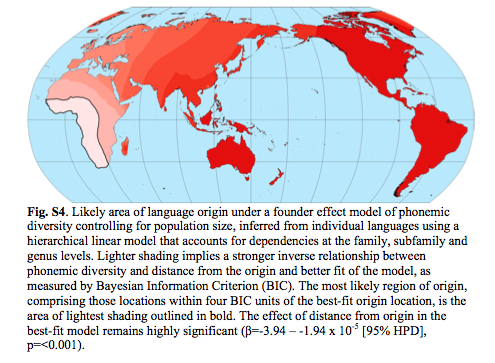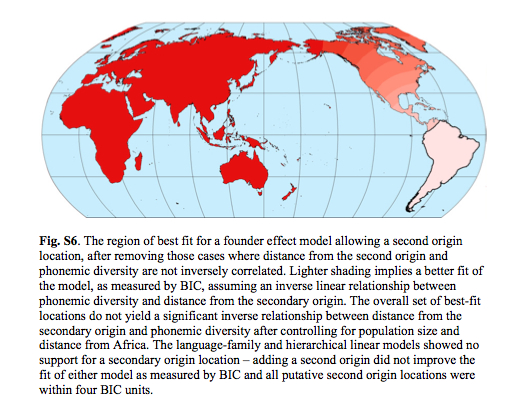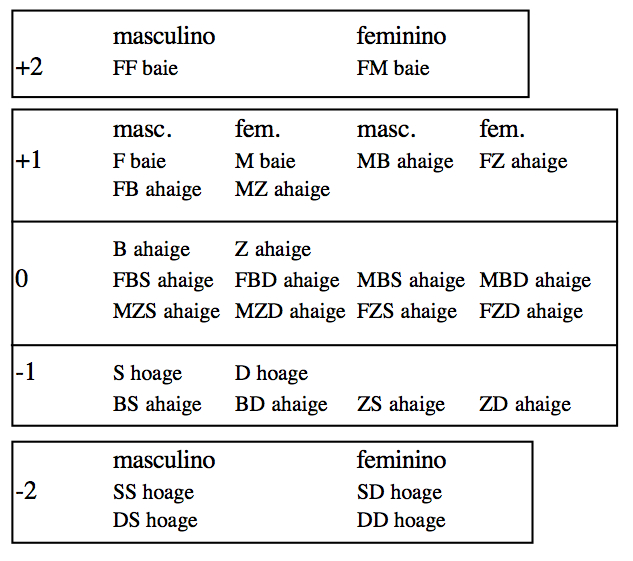Piraha Indians, Recursion, Phonemic Inventory Size and the Evolutionary Significance of Simplicity
Daniel Everett has a new book out that will surely stir more controversy around Piraha Indians, Chomskyan recursion and the evolution of human language.
 I haven’t read this book yet, but The Chronicle of Higher Education has an extensive coverage of the “Pirahagate” into which Everett propelled Chomskyan linguistics, but also of the political backlash that made Everett look like a “racist” and barred him from access to his Piraha Indians. Everett belongs to a broad cohort of missionary linguists who have done a great job documenting previously undescribed languages of South America and other remote regions, while simultaneously translating the Bible into local languages. Originally affiliated with the Summer Institute of Linguistics (SIL), Everett held a number of academic appointments in linguistics departments in the U.S. and the U.K. and is currently Dean of Arts and Sciences at Bentley University. Educated in the Chomskyan tradition, Everett later came to a realization that the Piraha language does not support the Chomskyan notion of a “universal grammar” rooted in our brain structure. Principally, this is because Piraha does not seem to have recursion, the fundamental property of a great majority of languages to embed clauses one into another in a Matreshka doll fashion. (See an amusing explanation of recursion by cognitive linguist, Daniel Harbour.) In addition to lacking recursion, Piraha lacks ordinal and cardinal numbers, color terms, their pronoun system is very simple and was apparently borrowed from Tupi-Guarani, and they use very few phonemes (12). It’s possible that Piraha women’s language has the fewest number of phonemes in the world, one phoneme fewer than Rotokas in Papua New Guinea (North Bougainville family). Piraha compensate for the paucity of their phonemes with well-developed whistled, sung and hummed linguistic registers.
I haven’t read this book yet, but The Chronicle of Higher Education has an extensive coverage of the “Pirahagate” into which Everett propelled Chomskyan linguistics, but also of the political backlash that made Everett look like a “racist” and barred him from access to his Piraha Indians. Everett belongs to a broad cohort of missionary linguists who have done a great job documenting previously undescribed languages of South America and other remote regions, while simultaneously translating the Bible into local languages. Originally affiliated with the Summer Institute of Linguistics (SIL), Everett held a number of academic appointments in linguistics departments in the U.S. and the U.K. and is currently Dean of Arts and Sciences at Bentley University. Educated in the Chomskyan tradition, Everett later came to a realization that the Piraha language does not support the Chomskyan notion of a “universal grammar” rooted in our brain structure. Principally, this is because Piraha does not seem to have recursion, the fundamental property of a great majority of languages to embed clauses one into another in a Matreshka doll fashion. (See an amusing explanation of recursion by cognitive linguist, Daniel Harbour.) In addition to lacking recursion, Piraha lacks ordinal and cardinal numbers, color terms, their pronoun system is very simple and was apparently borrowed from Tupi-Guarani, and they use very few phonemes (12). It’s possible that Piraha women’s language has the fewest number of phonemes in the world, one phoneme fewer than Rotokas in Papua New Guinea (North Bougainville family). Piraha compensate for the paucity of their phonemes with well-developed whistled, sung and hummed linguistic registers.
The way Everett described the Piraha language made it sound like the Piraha are not fully human, or using the language of phylogenetics, they were the first to branch off from the ancestral human population and they’ve largely retained the language structure and the culture of our ancestors. This made Everett into a “racist” in the eyes of some Western whistle-blowers. If those whistle-blowers only knew how geneticists portray Khoisan and Pygmies in Sub-Saharan Africa! According to some influential mtDNA phylogenies and dating exercises (see, e.g., Behar et al. “The Dawn of Human Matrilineal Diversity,” Am J Hum Genetics 82 (5), 2008), Khoisans split from the rest of modern humans between 90,000 and 150,000 years ago. Pygmies diverged next. These are astronomical figures considering that archaeologists date the emergence of material signs of behavioral modernity around the globe at 45-40,000 years ago. Khoisans, therefore, predate behavioral modernity by 100,000 years! Khoisans are also typically portrayed as closer to chimpanzees than any other human population in various autosomal PCA plots. Victor Grauer finds direct links between Khoisan and Pygmy vocalizing and bonobo chimpanzees.
The case of Piraha raises some methodological questions regarding the way we interpret simplicity and complexity, low diversity and high diversity in evolutionary terms. Geneticists have inculcated into people’s minds the idea that high levels of allelic diversity indicate the geographic homeland of a population or a species. Their kitchen logic is simple: a population accumulates diversity with time and when a daughter population branches off it takes with it to a new place only a small fraction of the diversity found in the parental population. Bigger is older, smaller is younger. No direct empirical proof has ever been adduced to demonstrate that this kitchen logic indeed guided the formation of extant continental patterns of genetic differentiation. There are other possible interpretations (population size, admixture, etc.). But for now let’s assume this kitchen logic is right. Translated into the language of phonemes, the greater the size of a phonemic inventory the older is the language. This is the logic that Quentin D. Atkinson (“Phonemic Diversity Supports a Serial Founder Effect Model of Language Expansion from Africa,” Science 332, 346-349 (2011) applied when he argued that phonemic inventory size declines with geographic distance from Africa, thus mimicking the fundamental claim that geneticists have put behind the the out-of-Africa model of human dispersals. Atkinson arrived at two possible homelands (see below, from his Suppl. Mat.) defined by either by the greatest inventory size or the smallest inventory size.
When Cysouw et al. (“Comment on “Phonemic Diversity Supports a Serial Founder Effect Model of Language Expansion from Africa,” Science 335, 657-b, 2012) replicated Atkinson’s regression model and the Bayesian Information Criterion (BIC) model with WALS and UPSID data, they found that Africa, Eurasia and North America are equally likely to possess the phonemic inventory size appropriate for the homeland, while Australasia and South America are equally unlikely. (Southeast Asia fell in the middle.) When Cysouw et al. added a quadratic geographic term into the regression model, “there was no change to the BIC area according to Atkinson’s measure. However, for the other two measurements of phoneme inventory size the clusters of minimal BIC languages shifted dramatically to the eastern tip of New Guinea. In this model, the origin of phoneme inventory size consists of languages with small phoneme inventories” (Cysouw et al. 2012, Suppl Mat, p. 20). South America and Australasia are the two world regions that have the smallest phonemic inventory sizes, and Piraha and Rotokas are the two languages approaching the absolutely lowest threshold. It means that under certain statistical scenarios South American Indians in general and Piraha in particular appear as the oldest spoken human languages. Evolution, therefore, proceeds from simple to complex, and not from complex to simple. But, again, under other statistical scenarios, it’s North America, with large phoneme inventories, is a possible source for all of human languages. In this case, evolution would go from complex to simple. Regardless of how we view evolutionary process, South America and Australasia seem to show pervasive similarities across genetic, linguistic and cultural systems that cannot be explained by chance.
But what if we include Piraha’s whistled and hummed sounds into their “phoneme” inventory? Not only that it will become more complex, it will become more heterogeneous due to the inclusion of such divergent meaning-building sounds as whistling and humming. A Southern Khoisan language !Xóo has one of the world largest phoneme inventories due to the fact that they possess such unique phonemes as clicks. Outside of Africa, clicks are virtually unknown. It’s unclear why some scholars believe that clicks are primordial human sounds, while whistling sounds are not.
In ethnomusicology, Australia and North America stand out as having very simple, monophonic vocal traditions, which Grauer labeled “iterative one beat,” coupled with the paucity of musical instruments. South American Indians and Papuans/Melanesians have more complex polyphonic traditions and larger musical instrument inventories. Khoisan and Pygmies have, according to Grauer, the richest multi-part, polyphonic musical traditions (and their Bantu neighbors have large inventories of musical instruments). Grauer interprets ethnomusicological patterns just like Atkinson interpreted phonemic evidence: his global cline replicates the genetic cline of decreasing allelic diversity with increasing geographic distance from Africa. Khoisans and Pygmies come out as having preserved the earliest human musical traditions better than any other human population, while American Indians (with the exception of South American Indians who preserved “canonic-echoic” vocal style and panpipe ensembles) and Australian aborigines replaced archaic complexity with cul-de-sac simplicity. But the whole scenario remains speculative, as it’s unclear why both very old and very recent musical traditions are found on the opposite end of the world from the putative African homeland, namely in South America, plus there’s little-to-no direct evidence for the epic collapse of African multi-part polyphony outside of Africa. At one point, Grauer seems to expose an “inconvenient truth”: a simple shouted hocket (Grauer’s basal type A1) of the kind known from Papua New Guinean Dani and Huli or Californian Hupa is performed as an “interlude between more complex songs” among African Pygmies and is known among them under a special name esime. This means that the primitive shouted hocket is found in a purer form outside of Africa, while among Pygmies it’s a survival embedded into later musical developments. One is left with an impression that Pygmy polyphony is a secondary elaboration of more primitive polyphonic styles just like typical Eurasian “elaborate solo,” in Grauer’s scheme, is an evolution of primitive “breathless solo.” According to classical evolutionism in ethnomusicology (see works by Bruno Nettle), American Indian vocal style that Grauer calls “iterative one-beat” is the primitive, rather than “advanced” stage in musical evolution. Grauer himself admits that the flexible and uncoordinated “canonic-echoic” style of polyphonic singing found in South America may represent the evolutionary prototype for rigid and coordinated Khoisan and Pygmy polyphony. In response to the fundamental divide in modern human musical traditions between multi-part, polyphonic, collective, relaxed, open-throated (read: “complex”) vocalizing and monophonic, solo, constricted singing a la Siberian “breathless solo” (read: “simple” vocalizing), Grauer’s mentor, Alan Lomax, postulated two homelands for modern human musical traditions – one in Africa, the other one in Northeast Asia. But it looks like the simplest versions of both macrotraditions are observed way outside of Africa, in the Circumpacific and Circumarctic areas.
In kinship studies, the most common evolutionary model is Claude Levi-Strauss’s theory of the development of human alliance systems from “elementary exchange” to “complex networks.” Elementary systems are found mainly in the New World, Australasia and South Asia, while complex systems are wide-spread in Europe, West Asia, North Africa and among Sub-Saharan agriculturalists and pastoralists. Elementary systems are based on the practice of prescriptive marriage between bilateral cross-cousins coupled with incest prohibitions, complex systems have no marital prescription, only incest prohibitions. In my global study of human kinship terminologies that led to the original formulation of an out-of-America hypothesis I noticed that in the regions with elementary alliance systems one finds systems that have some complexly differentiated kin classes. American Indian (and less so Australasian) kinship terminologies have some of the most complete and elegant lexical elaborations of maximum possible distinctions in the “sibling,” “parent’s sibling” and “parent’s parent” kin classes. At the same time, regions with complex alliance systems often have overdeveloped “cousin” and “in-law” kin classes. One can trace how complexities associated with “elementary” systems evolved into complexities associated with “complex systems.”
Now, Piraha does not have an elementary alliance system as defined by Levi-Strauss and his followers. Theirs is even more simple than Levi-Strauss could conceive (see below, from Gonçalves M. A. “O valor da afinidade: Parentesco e casamento entre os Pirahã,” Revista de Antropologia 40 (1), 1997, p. 66), with generations and lines collapsed under just three terms (baie, ahaige and hoage).
Everett notes (“Cultural Constraints on Grammar and Cognition in Piraha,” Current Anthropology 46 (4), 205, 630) that Piraha kinship terms lack recursion, so that a Piraha speaker can’t form constructions (that anthropologists call “descriptive” or “cumulative”) such as “mother’s brother” or “mother’s brother’s son.” Only one possessor per noun phrase is allowed. And, indeed, in the regions with elementary alliance systems (again, the New World, Australasia and parts of Asia) normative kinship terms are rarely, if ever, descriptive. At the same time, in the regions with complex alliance systems descriptive phrases employing Chomskyan recursion are commonplace. The first systematic student of human kinship systems, Lewis H. Morgan, already in the mid-19th century, divided the globe into regions with “classificatory” and “descriptive” kinship terminologies.
Judging by the corroborating evidence from kinship terminologies, Everett is onto something with his anti-recursive stance. In the very least, his work allows us to expose double-standard and ascertainment bias that has resulted in the artificial assignment of primordial qualities to genetic and linguistic patterns encountered in Africa and Europe and the corresponding dismissal of genetic and linguistic patterns observed in America and Australasia as later developments representing either an evolutionary dead-end or an observer’s error.





[…] paper attempts to show that phonemic diversity decreases with distance from Africa. I have already discussed some of the issues with using phonemic data to argue for a dispersion out of Africa and won’t […]
[…] Piraha Indians, Recursion, Phonemic Inventory Size and the Evolutionary Significance of Simplicity by German Dziebel, Anthropogenesis […]